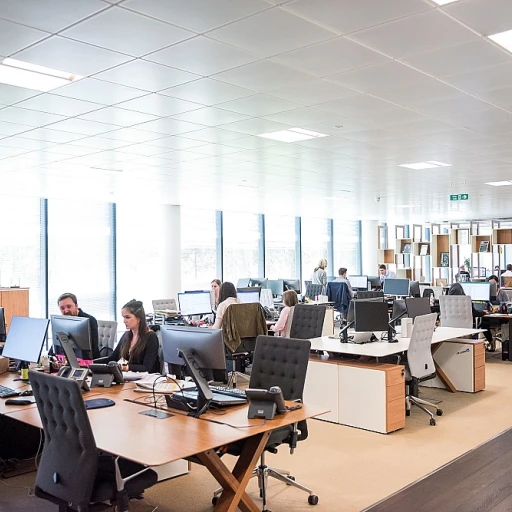-teaser.webp)
Understanding the Intelligent Workplace
The Essence of an Intelligent Workplace
An intelligent workplace is a transformative concept, encompassing numerous elements that seamlessly integrate to foster a more efficient, collaborative, and productive work environment. As organizations strive to adapt to an ever-changing landscape, understanding what defines an intelligent workplace becomes essential.
An intelligent workplace leverages technology to not only perform tasks but to enhance decision-making, streamline operations, and improve employee experiences. With the adoption of digital tools and systems, workplaces become more responsive and flexible, adapting in real time to the needs of the business and its employees.
The integration of smart technologies, including machine learning and artificial intelligence, allows an intelligent workplace to exceed the capabilities of a traditional office setup. By harnessing workforce managers' roles in modern organizations, these workplaces utilize data analytics and cloud computing to support data-driven solutions and collaboration across various platforms.
Furthermore, the intelligent workplace promotes hybrid work arrangements, empowering employees to choose flexible work environments that maximize productivity. By supporting both physical and digital workspaces, these environments cater to diverse needs, thereby enhancing employee engagement and satisfaction.
In summary, an intelligent workplace is not merely about adopting new technologies, but about fostering a holistic approach whereby digital integration, human interaction, and strategic planning coalesce to create an adaptive work environment.
The Role of Technology in Workforce Planning
Leveraging Technology for an Intelligent Workplace
Technology serves as the backbone of an intelligent workplace, driving efficiency and empowering employees. An array of digital tools and systems are transforming offices into dynamic environments, adapting to the needs of hybrid work arrangements.- Cloud Computing and Digital Tools: These solutions offer flexibility and enhance productivity by enabling remote collaboration. Employees can access work-related data and applications from anywhere, fostering agile work environments.
- Artificial Intelligence and Machine Learning: By implementing AI-driven analytics, workplaces can gain insights into workforce trends, optimizing employee deployment and productivity strategies. AI helps automate repetitive tasks, allowing employees to focus on higher-value activities.
- Smart Collaboration Tools: These tools facilitate real-time communication and document sharing among team members, regardless of their location. As a result, teams can maintain productivity and stay connected, whether in a traditional office or a digital workspace.
- Decision Support Systems: Using data analytics, decision-making processes become data-driven, leading to more informed and efficient strategies for workforce planning. Real-time data assists in making quick adjustments to align with business goals.
Enhancing Employee Engagement and Productivity
Boosting Interaction in New Workspaces
Enhancing employee engagement and productivity is crucial in the era of intelligent workplaces, where digital tools and advanced technologies streamline operations and foster effective communication. In this modern work environment, various solutions are employed to support employee engagement and ensure a rich employee experience.
Innovation in productivity tools is evident. Organizations are increasingly implementing cloud computing and digital workplace technologies to facilitate seamless collaboration. These platforms enable employees to perform tasks efficiently, regardless of their physical location. This shift towards hybrid work environments necessitates increasingly sophisticated digital tools, from intuitive booking software for shared office spaces to real-time communication applications.
The integration of artificial intelligence and machine learning into workplace systems helps automate routine tasks, allowing employees to focus on more strategic activities. These intelligent tools lessen the cognitive load, empowering the workforce to address more complex, creative challenges. Such an approach not only boosts productivity but also enhances job satisfaction by increasing focus on engaging tasks.
Personalizing Workflows for Enhanced Output
Data plays a vital role in personalizing employee interactions within an intelligent workspace. By harnessing data analytics, organizations can tailor work experiences to meet individual needs. For instance, systems can suggest optimal times for specific tasks based on an employee’s past productivity patterns, therefore optimizing their work schedule.
Moreover, the use of intelligent workplace technology encourages collaborative work cultures. By providing platforms where employees can easily share ideas, organizations create a smart environment that promotes creativity and innovation. These tools serve to break down silos, ensuring that all employees remain engaged and informed.
To learn more about effective strategies to enhance employee engagement and productivity within intelligent workplaces, visit our comprehensive guide on workforce planning strategies.
Flexible Work Environments and Their Impact
Creating Adaptive Work Environments
The modern intelligent workplace thrives on adaptability, enabling both businesses and employees to evolve with changing circumstances. This flexibility in work environments can have a significant impact on employee satisfaction and productivity. By integrating technology such as cloud computing and digital tools, businesses offer their workforce a hybrid experience—one that seamlessly blends in-office and remote work. This not only supports diverse working models but also enhances the overall employee experience.Tools and Technologies for Flexible Work
Implementing flexible work environments requires leveraging smart technologies. Solutions such as booking software and digital workplace platforms ensure that employees can access resources and collaborate effectively, regardless of their location. In intelligent workplaces, machine learning and artificial intelligence play fundamental roles in optimizing work tasks and workflows. These technologies enable more efficient management of human resources and foster a culture of collaboration and innovation.Impact on Employee Engagement and Productivity
As more offices transition to hybrid work models, the way employees engage with their work and colleagues is evolving. When empowered with smart systems and digital solutions, employees experience increased autonomy—and ultimately, higher levels of productivity. By facilitating real-time communication and data sharing, workplace technology becomes a catalyst for enhanced employee engagement. Data analytics further supports this by providing insights into employee behavior and preferences. Incorporating these strategies and technologies not only defines an intelligent workspace but also sets the stage for continued growth and innovation, critical to any organization's success in today's dynamic work environment.Data-Driven Decision Making
Leveraging Data-Driven Systems
In the ever-evolving landscape of the intelligent workplace, organizations are increasingly relying on data analytics to guide their decision making. The infusion of data-driven systems into workforce planning is revolutionizing how businesses operate and optimize their processes. With the rapid development in workplace technology, data analytics tools have become pivotal in enhancing productivity and efficiency.
Integrating these tools allows for real-time insights into workplace dynamics, employee performance, and resource allocation. Technologies like machine learning and artificial intelligence aid in processing vast amounts of data, leading to more informed decisions that can promptly address workforce challenges.
Real-Time Insights and Adaptability
One of the standout benefits of utilizing data-driven tools is the ability to gain real-time insights. This characteristic is vital in an intelligent workspace where tasks and responsibilities can shift rapidly. Real-time data facilitates agile responses to market changes, contributing to a more adaptable work environment.
Moreover, cloud computing enables seamless data storage and retrieval, ensuring that decision-makers have access to the most current information. This level of adaptability is crucial in supporting hybrid work models, where employees may operate across diverse environments.
Empowering Employees Through Data
Data-driven decision making also enhances employee engagement. By analyzing data on employee performance and satisfaction, organizations can tailor their strategies to improve the employee experience. For example, insights into collaboration patterns can help refine digital workplace solutions, ensuring that employees are supported in their roles and tasks.
Furthermore, leveraging digital tools and booking software aids in managing resources and office spaces with precision. Such solutions contribute to creating a smart and efficient work environment, aligning with both organizational objectives and individual employee needs.
In conclusion, data-driven decision making plays a crucial role in shaping an intelligent workplace. With the aid of advanced tools and technologies, businesses can better plan, execute, and refine their workforce strategies to stay competitive and foster a more effective work environment.
Future Trends in Intelligent Workplaces
Anticipating Tomorrow's Workplace Dynamics
As we look to the future, intelligent workplaces are set to evolve with advancements in technology and shifting employee expectations. The integration of artificial intelligence and machine learning continues to revolutionize how tasks are automated and optimized for enhanced productivity. Real-time data analytics will assume a more significant role, enabling companies to make informed decisions swiftly and efficiently.
Businesses are likely to invest more in smart systems tailored for hybrid work models, combining the flexibility of remote work with the benefits of in-office collaboration. This shift will demand adaptable digital tools and solutions designed to support seamless transitions between different work environments. As workplace technology becomes more sophisticated, emphasis on human-centric design is crucial to maintain employee engagement and satisfaction.
The rise of cloud computing and digital workplace platforms will promote more efficient collaboration and communication, breaking down barriers that traditionally exist within office spaces. These platforms will allow employees to access resources and information effortlessly, regardless of their location, thus fostering an inclusive and flexible work culture.
Looking forward, businesses must remain vigilant to the emerging trends shaping intelligent workspace solutions. By acknowledging the impact of digital transformation and adopting it proactively, organizations can ensure a future-ready work environment that thrives on innovation and adapts to the dynamic nature of the intelligent workplace landscape.














